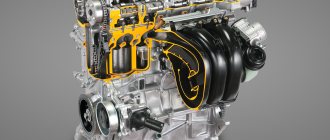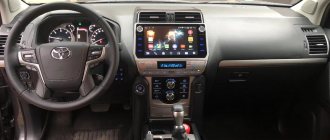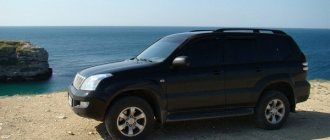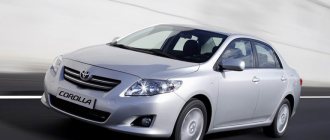Toyota Estima 3.0 4WD 5 doors. minivan, 220 hp, 4 automatic transmission, 2000 – 2003 - increased fuel consumption
Toyota Estima is a Japanese minivan car, known on the market since 1990. This is one of the largest minivans among competitors, with a large and comfortable interior. Under the name Estima, the car is sold only in Japan, while the model is exported as Toyota Previa. In most trim levels, the Toyota Estima was equipped with all-wheel drive, which is a rarity in the class. Therefore, the car was considered one of the most expensive minivans. To date, three generations of Toyota Estima are known, the third generation has been produced since 2006.
5Hello everyone! I decided to measure fuel consumption while driving in the city. As soon as I bought it, I immediately filled the tank to full. I rode 265 km, filled it up to full - 57 liters fit. Conditions: 92 petrol. Rear lambda (heating) does not work, frequent warm-ups, snowfall and crawling always on. 4WD button, and minimum distances... Total consumption was 21 liters and 500 g per 100 KM. Next, we change the lambda, fill the tank to full and drive from Kolomna to Moscow to Monica. Conditions: 95 petrol, oxygen works, to the address in Moscow, the maximum speed was 110 km/h, in Moscow the car rattled for almost an hour and a half (not to freeze)) and back, but we stood in a traffic jam for a bit and the maximum speed was 120 km/h... Filled up to full, drove 231 km and took 26 liters. Total consumption 11l 255g. Well, something like this)... Now there will be a measurement in the city. 95 petrol. Under the first condition, but with a working probe. Let's see what it shows)) I took a measurement, it turned out like this. 95benz Lukoil (it somehow felt better on 92), lambda works, no errors, city, warming up, short distances, well, a couple of times, slightly aggressive driving, well, I pressed the floor twice (the snow melted). drove 233.1 km, it took 60 liters = consumption turned out to be 25.7 per 100 km.)))) either it’s the lambda, or they’ve now topped up more gasoline until it’s full (at that gas station the arrow was at the top mark, at this gas station it was above the mark, under the cap) ... well, in general, something like this) we measure 92 under the same conditions, I’ll try not to drown)) The gasoline froze again ... 92 gasoline, we only drive in the city, warming up 6 km of the way, warming up 6 km back - drove 212 km, and filled up 58 liters = 27l per 100km... That’s a bit too much, isn’t it? The diagnostics revealed no problems - the readings of the two sensors at idle are identical on the oscilloscope... if at speed... then the new universal one jumps right away... the old one is a “cardiogram of a dead heart”, then like the first new one... but the new one somehow reacts more quickly at speed...(the electrician said there was nothing criminal). Another gas station. Now I drove 100 km through the city, and the consumption was 22 liters... the car began to warm up more (when the temperature arrow stood between the marks - the middle one in the middle and the bottom one - between them). Before this, I was driving as soon as the needle rose to the bottom mark, and so it was on so that 4th gear was in the box... Before that, I was driving in 3 gears, up to 60 km per hour. I will definitely change the second lambda now...
I decided to add... I went on vacation to the Voronezh region. In general, the consumption on the highway was almost empty - it was 10 liters per 100 km of 92nd gasoline... I went to Kudykina Mountain with 8 people and food. Also 10 liters per 100 of the same gasoline, which came out to 660 km... Then I went back at the end of the vacation to the Moscow region... refueled along the M4 on the right at Lukoil behind Losev... drove 441 km in 120 mode constantly and then topped up with 42 liters of 92... In short, damn, good gasoline there))) it came out to 9 liters 500 grams... and it came loaded with supplies from the village ))) The car was shooting simply unrecognizable... in half a year of operation it has never happened...
Reviews of Toyota Estima 2003 minivan/Toyota
Toyota Estima Lucida (1997, Minibus)
Automatic transmission 2500 cm³ Left 280000 km 380000 km 2007 - 2011 Russia Kemerovo region.
Igor Bychkov 04/02/2011:
“The car is as reliable as a T34 tank.
Of course, frosts of -36 -40 are not good for anyone. The main ailments are from frost and roads. But this cannot be avoided in the place where I live. Roomy, large (I chose it because of the ability to sit freely in the cabin), visibility is very good. Sitting on the right, visibility is better (and therefore, safety is higher) than in a nine with left-hand drive. Although permanent all-wheel drive reduces fuel consumption, reliability is more important to me. And all-wheel drive has come to the rescue more than once in terms of stability on the highway. In Samara model 14 I didn’t drive less than 140 km/h, the maximum speed was 180. I switched to Lucida and somehow the car itself didn’t make me want to drive fast. I drive 100 - 130 km/h. No, of course, 160 km/h is not a problem, the car moves and doesn’t kick, but somehow you don’t want to. A family car is its main purpose. Spacious. In general, I think there is only one downside - the high fuel consumption of a gasoline engine. I have 16L in the city in winter, 14L in summer. True, the trial leaves an imprint on my driving style - fast and sharp. Calm drivers will probably still be able to save money. On the highway, consumption is in the range of 12.5 - 13l. The engine under the driver's rear provides good stability. Very warm - in winter at -25 -30 I ride in a T-shirt. I don't want to change it. If only for a completely new technology like the E mobile. As I pointed out earlier, cold and expensive conditions are the main enemy of a car. Well, of course, there is still time. Although in Lucida it runs according to its own laws. 1. Frosts I basically don’t put it on warming up. I fill it with 0W40 oil and it starts up fine. There is even a strange dependence: in the warm season it is worse to start than in winter. Up to - 26 -28, this dependence persists (it starts at half a turn), and then it stops abruptly, sometimes at - 36 it starts normally, sometimes it doesn’t want to. A friend suggested that it depends on gasoline. Looks like he's right. But you need to experiment. There seems to be a pattern. Usually I fill up with 92 gasoline, in cold weather I try to fill up with 95 and this helps somewhat. The problem is that in cold weather the starter spins quickly, there are no flashes, and gasoline does not ignite. Most likely, either the gasoline is crap (which is more likely), or the electronics flood the spark plugs in the cold (but this is not a fact). Another problem with frost is the suspension, until the oil in the shock absorbers starts working normally, it takes quite a while. I warm up on the go, which makes it faster. The main thing is not to break away, but to drive without tension. 2. Roads Of course, this includes cast aluminum already welded 3 times. discs and a crack in the glass, chips on the front end, damage to the exhaust system. The suspension is holding up well - no knocks or squeaks, although I drive 30,000 km a year. I changed the shock absorbers, the rest is not needed yet. 3. Time passes slower in Japanese cars than in Russian ones. But here, too, something needs to be changed from time to time. Changed: pressure sensor - spitting oil. The crankshaft oil seal is the consequences of severe frosts or time, shock absorbers - they were killed by the road engine without a pump. (I installed the VAZ and I don’t worry, there are no problems, I just re-soldered the connector wiring) belts, spark plugs, filters, washed the injector - everything seems to be the usual procedure. Access to the engine is a separate issue (but there’s not much to do there, the engine is reliable). but when necessary, he adapted and always had access within 15 minutes. And I’ll tell you one more trick - it doesn’t pull well - change the fuel filter. My most replaceable item. I don’t know what floats there, but it gets clogged very often. That is, he eats, but rather sluggishly. As soon as you change it, it immediately vomits. One time I refused to go at all. I changed the filter - just like they changed it. Not gasoline, but shit!” expandcollapse
Interior of Toyota Estima hybrid • It all started with him
Not a bad design, spacious interior, low price, spacious trunk where a baby stroller and junk could be placed, but the cutie’s gas mileage was not childish - 20 liters per 100 km, the problem can be said to be one coupling on the shaft of the attachment and gasoline consumption due to the failure of the oxygen sensor which cannot be changed at a reasonable price in our city. Over the 5 years of using the car, I have only encountered a few problems; it is a little expensive to maintain and clean the interior; it is quite large; that seems to be all the problems I have encountered.
What kind of insurance do you take out?
CASCOOSAGO
Technical Specifications • Technical Specifications
| Reviews of Toyota Estima 2000 Hybrid minivan (Toyota reviews) The new installation is comfortable to use and safe thanks to the control electronics, but you should remember that the active battery discharges quickly. I haven’t done it and I haven’t sold it for 10 tons of km yet, in principle there is no difference, only in traffic jams the battery doesn’t die; the service department said to put it in the parking lot, then it will die from the electric motor-generator in the box, but I didn’t bother; the battery doesn’t discharge below one division, but Consumption in the city increased by 2 liters to 11 liters per hundred, which is not critical for the pocket. |
- 2.4, 160 l. s., manual, rear-wheel drive, consumption – 14.1/6.8 l per 100 km
- 2.4, 132 l. p., automatic, rear/all-wheel drive.
Features of the power plant • high seating position, but there is one drawback: the transfer gearbox is located low, it’s good that there is protection on it, otherwise it can break.
Reviews of Toyota Estima Rating: 4.6 out of 5 46 reviews found
02.07.2017
My wife and I were looking for something family-friendly, so that we could go out into nature and not be embarrassed to drive around the city. At Toyota Istim was immediately struck by its clever design. Real grace! This is rare for such a giant. We ordered and waited almost 3 more months, but it was worth it. It arrived just in time for summer - when we travel the most. Choosing between different modifications (2, 4 and 3-liter with different drives and a hybrid), I decided not to take risks with a hybrid and not take the phlegmatic 2, 4. Therefore, I am now the proud owner of a front-wheel drive 3-liter. The interior is spacious, as expected, you can move back and forth quite calmly inside the car (I am 177 cm tall). He can stretch his legs either lengthwise or across as desired. We calmly drove the Istim to the south - the middle and rear seats turn into sleeping places, and my wife, my children and I had enough room to rest. Don’t expect any particular nimbleness on the roads, much less in the city. But there is no heaviness either. The dynamics are excellent. It gets off the ground surprisingly well. It easily picks up speed to 170 (I, of course, already tested this without passengers, otherwise my wife would go crazy). Another plus is that it is not particularly gluttonous - around the city it takes about 10 liters. An amazingly well-thought-out car: the suspension seems to be made for our roads - it lubricates all the holes and irregularities, although it cannot be called particularly soft. On the road she behaves like an excellent student. Only in cold weather the racks become a little tanned. But this is without movement. As winter has shown, frosts are not scary for her either (or rather, for her passengers!). Just need to stock up on good studded tires! There is also a separate heating for the rear seats. The only thing is that in severe frosts the brakes are a little late when releasing, but in no case do they lock up! There is also a difficulty: all the instructions are in Japanese, I just can’t figure out the multimedia system, although it doesn’t record a CD by default. If anyone knows what's what, write! The ground clearance is a little low, but it doesn’t seem to have caught on anything yet) The automatic door is nice, otherwise no one except the driver remembers that there is no need to slam the door! The rear optics are simply cool. I was surprised by the presence of a rear view camera, which comes in handy here (the car is not small after all) + radar parking sensors. In fact, Istima is for a family: how many pockets, recesses, glove compartments there are - it’s just some kind of horror. You can shove anything. In general, this minivan is clearly for aesthetes - a beauty in everything: from the body to the control panel! Even the instruments are all made in such a way that you can drive off the road just looking at them. I read the reviews before buying it. They said it was difficult to maintain, especially the engine. I can’t say anything about this yet - there was no reason to send it to the service. I only changed the standard ones - oil and filters. When I have such an experience, I will write separately. Also: IMHO, it’s better to take the typewriter in color. She looks so much more interesting. I have burgundy. By the way, the quality of the paint is excellent. Easy to clean, but difficult to scratch! Good luck to everyone on the roads!
Exterior Toyota Estima hybrid: First generation
| Toyota Estima 2.4, 3.0 fuel consumption and reviews from real owners of diesel and gasoline engines with manual and automatic (robot) If we take into account the modern approach to configuration, we can count on the presence in the car of a heating system, an immobilizer, and an all-wheel drive disabling system etc. Not a bad design, spacious interior, low price, spacious trunk where a baby stroller and junk could be placed, but the cutie’s gas consumption was not childish - 20 liters per 100 km, the problem can be said to be one coupling on the shaft of the attachment and gasoline consumption due to the outlet building an oxygen sensor that cannot be replaced at a reasonable price in our city. |
| Toyota Estima 3. 0 4WD / Toyota Estima, 5 door minivan, 220 l. s, 4 automatic transmission, 2000 - 2003 - increased fuel consumption The technical characteristics are good, but do not forget about the safety of Estima or the engine size, which will then make itself felt in operating costs in the future, as well as Estima repairs and maintenance with a warranty period. In the winter, without Webasta, in city traffic jams you will give a dubak, and don’t say that it heats up without load, I’ve been on diesel engines all my life, in the furnace atnigel if the diesel engine is shit, but it’s SHIT. |
Toyota Estima MCR40 › Logbook › Fuel consumption… • Therefore, the car was considered one of the most expensive minivans.
Buying a Toyota Estima Lucida or why I don’t like used diesel.
Purchased a Toyota Estima Lucida several years ago. My review of the Toyota Lucida and engine replacement on this wonderful minivan.
We all make mistakes. The only difference is how hard these mistakes hit us in life and how much it costs to correct these mistakes. I also made mistakes in my life, and I will tell you about one of them today.
This was about ten years ago, when I had not yet touched the automobile business and worked in a completely different structure. There was no money, I drove old foreign cars and periodically changed them, because in the same hands old cars begin to crumble, no matter how you repair them. I saved up a certain amount of money, sold my old car and started looking for a new one. At that time, it was not possible to find an auto expert; there was no diagnostic equipment as such, and you had to rely solely on your own instincts. That's what I did.
When searching, I made two mistakes: I was not looking for a specific brand of car, but by budget (later I’ll definitely make a post about why you can’t search for a car by budget) and I was considering options with a diesel engine (there will also be an article later on why you shouldn’t buy a used diesel from a stranger).
After examining several options for a budget of up to 200,000 rubles, I liked this beauty, Toyota Estima Lucida.
Since I am a very small person, I really fetishize the thrill of big cars. I also had experience driving right-hand drive cars, so it didn’t bother me. Let's go watch.
Upon closer inspection of the car, it turned out that it was quite alive and looked quite vigorous for its age and money. The diesel engine runs smoothly, does not smoke, the engine is dry and does not smell at all, what else is needed for happiness?
We drew up a purchase and sale agreement and I, happy, drove towards the house. Let me clarify that at that moment it was winter outside. I was driving from the other end of Moscow and I didn’t like that the stove didn’t heat well, that is, it was cool in the car. Okay, I think we'll figure it out later. This was the first call!
As they say, if you are unlucky with a car at first, it will be so all the time. This morning in the parking lot I discovered a scratch the entire length of the side from a key or a screwdriver. Of course I was upset, but I went to register the car. The second bell rings, isn't it?
The traffic police found out that something was written incorrectly in the contract, and you need to go to the office where it was drawn up. The third call, but Nikita is an extremely stubborn person, he solved this problem too. I registered the car, secured the license plates and drove home.
The next day, my friend asked me to take him somewhere to the other end of Moscow, like “let’s go for a ride at the same time.” No sooner said than done, we jump into my “new” bus and rush towards the Moscow Ring Road. On the Moscow Ring Road, the engine temperature begins to rise inexorably. I stop, open the hood: oh my, there is no antifreeze in the expansion tank! We cooled down, drove to the nearest gas station and bought a liter of antifreeze (naive










